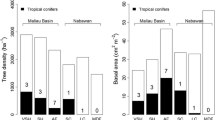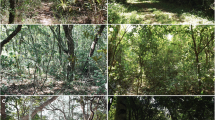Summary:
In order to support an appropriate species selection for the establishment of mixed forest stands, we studied the changes in growth and leaf traits of four tree species (Fagus sylvatica L., Acer pseudoplatanus L., Tilia platyphyllos Scop., Fraxinus excelsior L.) along a hillside gradient. The nutrient-rich soils at the study site in North-Hesse (Central Germany) are derived mainly from basalt. The volumetric stone content was 10% on the lower slope and 25% on the upper slope (0–10 cm soil depth). Sycamore, beech and broad-leaved lime trees were planted after the breakdown of a Norway spruce stand. Ash migrated into the stand by natural regeneration. The studied trees were about 6 years old. In both study years, the height increment decreased along the gradient for all species. The increment was lowest for sycamore on the upper slope where only 16% of the increment on the lower slope was observed (beech 36%, broad-leaved lime 48%, ash 47%). Leaf sizes and leaf areas per tree decreased and stomatal densities increased along the gradient indicating a response to decreasing water supply. Within a species no significant differences of leaf δ13C values were observed on the different slope positions, which suggests that there was no change in the water use efficiency of photosynthesis at the leaf level. Foliar N and K contents were highest on the lower slope plot and lower on the mid- and upper slope, which does not reflect differences in soil chemical conditions. We assume that plant nutrition was impaired mainly by soil water shortage. Following these results, ash and broad-leaved lime appear to be more suitable tree species for the establishment of mixed forests at nutrient-rich sites with restricted water supply than sycamore. Beech occupied an intermediate position.
Zusammenfassung:
Mit dem Ziel die Baumartenwahl für die Begründung von Mischwäldern zu unterstützen, haben wir das Wachstums und die Blatteigenschaften vier verschiedener Baumarten (Fagus sylvatica L., Acer pseudoplatanus L., Tilia platyphyllos Scop., Fraxinus excelsior L.) entlang eines Hanggradienten untersucht. Die Untersuchung wurde in Nordhessen auf einem Basaltstandort durchgeführt. Am Unterhang wies der nährstoffreiche Boden einen Skelettanteil von 10 Vol.% und am Oberhang von 25% auf (0–10 cm Bodentiefe). Bergahorne, Buchen und Sommerlinden wurden nach dem Zusammenbruch eines Fichtenbestandes gepflanzt. Eschen fanden sich als Naturverjüngung im Bestand ein. Die untersuchten Bäume waren etwa 6 Jahre alt.In beiden Untersuchungsjahren nahm der Höhenzuwachs der untersuchten Baumarten entlang des Gradienten ab. Die Reduktion war am höchsten beim Bergahorn, dessen Zuwachs am Oberhang nur 16% des Zuwachses am Unterhang betrug (Buche 33%, Sommerlinde 48%, Esche 47%). Die Blattgrößen und die Blattfläche pro Baum nahmen vom Unterhang zum Oberhang ab, während die Stomatadichten anstiegen, was eine Reaktion auf abnehmende Wasserverfügbarkeit anzeigt. Innerhalb einer Art wurden keine signifikanten Unterschiede der δ13C-Werte von Sonnenblättern an den verschiedenen Hangpositionen gefunden. Dies deutet darauf hin, dass es auf Blattebene keine Änderung der Wassernutzungseffizienz der Photosynthese gab. Die N- und K-Gehalte der Blätter waren am Unterhang am höchsten und am Mittel- und Oberhang geringer, was nicht die chemischen Eigenschaften des Bodens widerspiegelt. Wir nehmen an, dass die Pflanzenernährung durch eine abnehmende Bodenwasserverfügbarkeit eingeschränkt war. Diesen Ergebnissen zufolge sind Esche und Sommerlinde besser für den Anbau auf nährstoffreichen Böden mit einer begrenzten Wasserversorgung geeignet als Bergahorn; Buche nahm eine Mittelstellung ein.
Similar content being viewed by others
Author information
Authors and Affiliations
Corresponding author
Rights and permissions
About this article
Cite this article
Hölscher, D., Schmitt, S. & Kupfer, K. Growth and Leaf Traits of Four Broad-Leaved Tree Species along a Hillside Gradient. Forstw. Cbl. 121, 229–239 (2002). https://doi.org/10.1046/j.1439-0337.2002.02031.x
Issue Date:
DOI: https://doi.org/10.1046/j.1439-0337.2002.02031.x
Keywords:
- Acer pseudoplatanus
- Fagus sylvatica
- Fraxinus excelsior
- Tilia platyphyllos,
- mixed forest stands
- water supply




